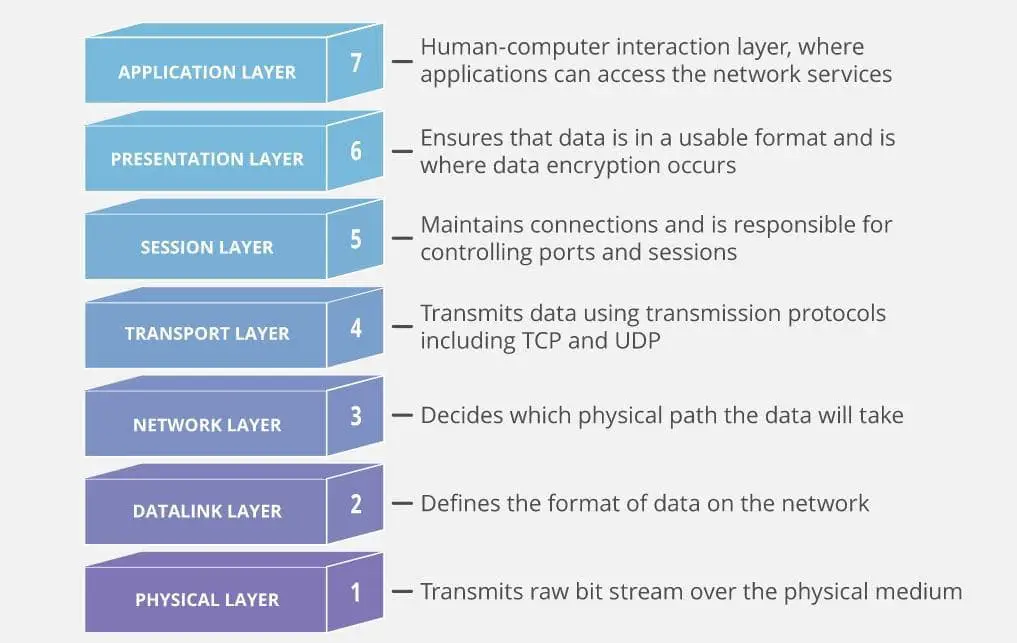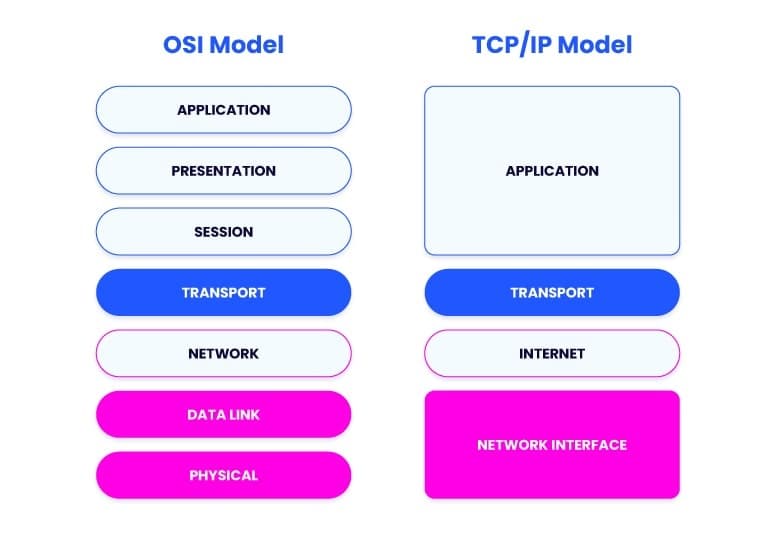The OSI model or Open Systems Interconnection Model is a conceptual framework used to describe the functions of a computer network into seven distinct layers. Developed by the International Organization for Standardization (ISO) in the late 1970s, the OSI model provides a systematic approach to understanding how data is transmitted and processed across networks. In this article, we will explore What is OSI Model in a computer network, its purpose, and the significance of its seven layers in facilitating seamless communication within computer networks.
OSI Model in Computer Network Explained
In the OSI reference model, the communications between a computing system are split into seven different layers. And each layer has its own specific roles and responsibilities, contributing to the overall efficiency, reliability, and security of data transmission.
- Physical Layer: Handles the actual transmission of raw data bits over physical media and defines electrical and mechanical aspects of the network.
- Data-Link Layer: Provides error-free transmission of data frames between directly connected nodes, manages flow control, and establishes reliable connections.
- Network Layer: Handles logical addressing, routing, and packet forwarding across multiple networks to ensure data reaches its destination.
- Transport Layer: Establishes end-to-end communication between source and destination hosts, ensures reliable and efficient data transfer, and provides error recovery and flow control.
- Session Layer: Manages session establishment, maintenance, and termination between network applications, allowing synchronization and recovery of data exchange processes.
- Presentation Layer: Handles data formatting, encryption, and compression, ensuring compatibility between different systems and facilitating the proper interpretation of data.
- Application Layer: Provides network services directly to user applications, allowing functions such as file transfer, email, web browsing, and remote access.
Physical Layer
The Physical Layer is the lowest layer of the OSI model and deals with the actual transmission of raw data bits over physical media such as cables, LAN cards, or wireless connections. It defines the electrical, mechanical, and functional aspects of the network interface, including specifications for cables, connectors, data rates, and signal modulation techniques.
The main functionality of the physical layer is to transmit the individual bits from one node to another node.
The physical layer is where data is converted into a bit stream, which is a string of 1 and 0. And both physical data.
Data-link layer
The second layer in the OSI model is the Data link layer or protocol layer, which is responsible for the deliver data into and out of a physical link in a network. The Data Link Layer provides error-free and reliable communication between directly connected nodes. It ensures the integrity of data by detecting and correcting errors that may occur during transmission.
The main function of Data link layer is to ensure that the data transfer above the physical layer is from one node to another without error.
The data link layer encompasses two sub-layers, media access control (MAC) provides flow control and multiplexing for device transmissions over a network and logical link control (LLC), provides flow and error control over the physical medium as well as identifies line protocols.
Network Layer
The Network Layer enables end-to-end packet forwarding and routing in a network. It deals with logical addresses such as IP (internet protocol) and determines the optimal path for data packets to reach their destination across different networks. In the OSI model, The Network Layer encapsulates data into packets, adds source and destination addresses, and makes routing decisions based on network conditions and addressing schemes.
Routers and gateways operate in the network layer.
Transport Layer
The Transport Layer establishes end-to-end communication between source and destination hosts. The primary function of the Transport Layer is to ensure reliable and efficient data transfer by providing error recovery, flow control, and congestion avoidance mechanisms. It receives the data from the upper layer and breaks down large data segments into smaller units known as segments, manages their sequencing, and establishes connections or sessions between applications.
The transport layer is called the Heart of OSI model.
Session Layer
The Session Layer manages the establishment, maintenance, and termination of sessions or connections between network applications. It enables synchronization, checkpointing, and recovery of data exchange processes. This layer also handles security and authentication aspects of session establishment, allowing two applications to communicate securely and effectively.
The Session layer in OSI model determines how long a system will wait for another application to respond.
Presentation Layer
The Presentation Layer also called the translation layer is responsible for data formatting and conversion. It ensures that data sent by the Application Layer of one system is readable by the Application Layer of another system. This layer performs tasks such as data encryption, compression, and protocol conversion. It allows applications to interpret the received data correctly, regardless of the differences in their internal representations.
The Presentation Layer defines how two devices should encode, encrypt, and compress data so it is received correctly on the other end.
Application Layer
The Application Layer also called Desktop Layer interacts directly with end-user applications. It provides network services directly to user applications, such as email, web browsing, file transfer, and remote access. This layer interacts with software applications and facilitates their communication with the underlying network layers. It defines protocols and standards for application-level services and supports user interactions with the network.
In OSI mode Application layer also acts as a window for application services to access the network and display information received by the user.
OSI model vs. TCP/IP model
The OSI (Open Systems Interconnection) model and the TCP/IP (Transmission Control Protocol/Internet Protocol) model are two conceptual frameworks used to understand and describe computer network protocols and communication. Both models serve similar purposes, but they differ in their approach and scope.
OSI model consists of seven layers Physical, Data Link, Network, Transport, Session, Presentation, and Application. But TCP/IP model comprises four layers: Network Interface, Internet, Transport, and Application.
OSI model is a conceptual framework that provides a theoretical foundation for understanding and designing networks. On the other hand, the TCP/IP model is more practical and is based on the actual protocols that were developed and widely used on the early Internet.
TCP/IP model is closely associated with the specific protocols developed for the internet, such as TCP, IP, UDP, and ICMP. But OSI model is more general and agnostic to specific protocols. OSI model is mainly used for educational and reference purposes, TCP/IP model is widely adopted and used as the de facto standard for internet communication.
FAQ:
What is the OSI model in computer networks?
- The OSI model is a framework that defines how different components of a computer network interact and communicate with each other.
What are the seven layers of the OSI model?
- The seven layers of the OSI model are Physical, Data Link, Network, Transport, Session, Presentation, and Application
What are the benefits of the OSI model?
- The benefits of the OSI model include standardization, modularity, interoperability, clear communication, and scalability.
Is the OSI model still relevant today?
- Yes, the OSI model is still relevant as it provides a conceptual foundation for understanding network communication and is applied in various networking technologies and protocols.
Why is the OSI model important for networking?
- The OSI model is important for networking because it provides a common framework for understanding and discussing network protocols, configurations, and troubleshooting.
How does the OSI model relate to the TCP/IP model?
- The TCP/IP model is a practical implementation of network protocols used on the internet, while the OSI model is a conceptual framework.
Also read:



